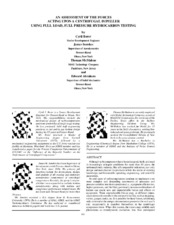| dc.description.abstract | Although turbocompressors have been designed, built, and used in increasingly stringent conditions for more than 80 years, the turbomachinery industry, like all comparable industries, can only design and manufacture its products within the realm of existing knowledge and foreseeable operating, engineering, and scientific parameters. As end users of turbocompressors continue to implement ever more complex and demanding assortments of processes and process variables into their operations (i.e., equipment efficiencies, higher pressures, and the like), previously unseen combinations of factors can create new and unpredictable forces and effects on equipment. These unpredictable forces may, at different times, cause destructive results in the end user's facility, such as in piping, valves, gauges, tanks, etc. It is possible for these forces, which may only exist under the unique circumstances present at the end user's site, occasionally to manifest themselves in the centrifugal compressor rotor. When this occurs, the rotors may exhibit such phenomena as rotordynamic excitation, less than anticipated aerothermal performance, or even a physical failure of a rotor or other component. When this unfortunate circumstance occurs, turbocompressor OEMs dedicated to both customer satisfaction and continued expansion of knowledge and technical responsiveness, will investigate (typically in cooperation with the end user) to determine, if possible, the full range of dynamics that may be occurring during process operation at the end user's site, so that the turbomachines can, if possible, be made to withstand the unforeseen forces. These efforts typically involve some combination of analytical studies and research testing; analytical work to provide a sound computational model, and testing to provide the data necessary to calibrate or bound the models. The test program and results described herein represent an OEMs and end user's efforts to identify the cause of repeated impeller failures in an offshore gas reinjection compressor. A machine identical to the field units was fully instrumented with aerodynamic and mechanical instrumentation (including radial and axial vibration probes, dynamic and static straingauges, dynamic pressure transducers, and other interstage pressure and temperature instrumentation). The compressor was then tested at full load and full pressure on hydrocarbon gas at the OEMs facility. Descriptions of the instrumentation and test procedure are provided. Concurrently, analytical efforts were undertaken to help understand the aerodynamic forces that may be contributing to the failures. Results from both the testing and the computational studies are presented along with the conclusions derived from both efforts. | en |


